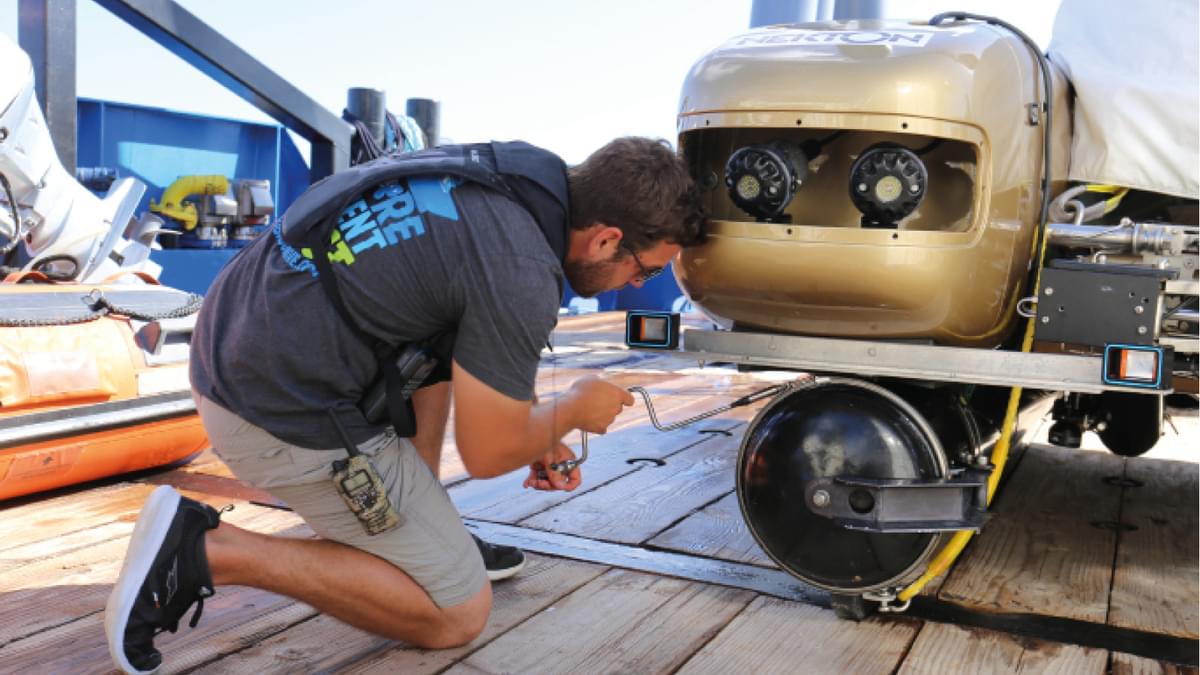
Submarine engineer
In this activity you will learn about the principles of buoyancy and especially neutral buoyancy. Divers, submersibles and submarines alter the air levels in their buoyancy systems to change their density. In this challenge, you will need to create a neutrally buoyant pen lid submarine.
Preparation
Prepare your resources, each group / student will need a clear plastic soda bottle, a pen lid (without a hole in the top) and some modeling clay or sticky-tac. Remove any labels from your bottle so that you can see what is happening. Before the session fill the bottle to the very top with water.
Session steps
1. Introduction (5 mins)
Jamie will open the session with a welcome and brief introduction to the expedition and any shout-outs to registered classes.
In this activity students will observe how neutral buoyancy is achieved through changing the balance of water and air, in the same way divers and submersibles alter their air levels to ascend and descend.
2. Subject knowledge (10 mins)
Jamie will then explain that this activity is all about density. When you squeeze the sides of the bottle, the air trapped inside the pen lid is compressed. This makes the pen lid more dense than the water, as the air bubble is smaller. As it is now less dense than the water, the pen lid sinks. When you release the sides of the bottle, the air bubble is no longer compressed and the volume of the air increases. This makes the pen lid less dense than the water, so it rises.
3. Activity time (15 mins)
Jamie will then begin demonstrating the activity and students can follow along in real-time. Fix a small piece of modelling clay to the end of the point on the pen lid. Put the pen lid into the bottle, modeling clay end first. It should just barely float, i.e. about 10cm from the top of the bottle. Now screw on the bottle cap nice and tight. Remember to top up the water bottle if you have lost any water getting the amount of modelling clay right. Now to see if you can make your pen lid submarine rise and fall. Squeeze the sides of the bottle hard. This should make the lid sink. If you stop squeezing, the lid will rise again. The challenge is to apply just the right amount of pressure to make the pen lid float in the middle of the bottle.
At this point, you can submit your students’ questions via the live chat.
4. Q&A and conclusion (15 mins)
After completing the activity Jamie will be able to answer pre-submitted questions and take part in the live chat. At the end of the broadcast, Jamie will suggest some other activities you might like to try and what's coming up in the rest of Submarine Live 2019.
Speakers

Jamie Buchanan-Dunlop
Executive Director, Encounter Edu
Brought to you by


Submarine engineer
In this activity you will learn about the principles of buoyancy and especially neutral buoyancy. Divers, submersibles and submarines alter the air levels in their buoyancy systems to change their density. In this challenge, you will need to create a neutrally buoyant pen lid submarine.
Preparation
Prepare your resources, each group / student will need a clear plastic soda bottle, a pen lid (without a hole in the top) and some modeling clay or sticky-tac. Remove any labels from your bottle so that you can see what is happening. Before the session fill the bottle to the very top with water.
Session steps
1. Introduction (5 mins)
Jamie will open the session with a welcome and brief introduction to the expedition and any shout-outs to registered classes.
In this activity students will observe how neutral buoyancy is achieved through changing the balance of water and air, in the same way divers and submersibles alter their air levels to ascend and descend.
2. Subject knowledge (10 mins)
Jamie will then explain that this activity is all about density. When you squeeze the sides of the bottle, the air trapped inside the pen lid is compressed. This makes the pen lid more dense than the water, as the air bubble is smaller. As it is now less dense than the water, the pen lid sinks. When you release the sides of the bottle, the air bubble is no longer compressed and the volume of the air increases. This makes the pen lid less dense than the water, so it rises.
3. Activity time (15 mins)
Jamie will then begin demonstrating the activity and students can follow along in real-time. Fix a small piece of modelling clay to the end of the point on the pen lid. Put the pen lid into the bottle, modeling clay end first. It should just barely float, i.e. about 10cm from the top of the bottle. Now screw on the bottle cap nice and tight. Remember to top up the water bottle if you have lost any water getting the amount of modelling clay right. Now to see if you can make your pen lid submarine rise and fall. Squeeze the sides of the bottle hard. This should make the lid sink. If you stop squeezing, the lid will rise again. The challenge is to apply just the right amount of pressure to make the pen lid float in the middle of the bottle.
At this point, you can submit your students’ questions via the live chat.
4. Q&A and conclusion (15 mins)
After completing the activity Jamie will be able to answer pre-submitted questions and take part in the live chat. At the end of the broadcast, Jamie will suggest some other activities you might like to try and what's coming up in the rest of Submarine Live 2019.
Speakers

Jamie Buchanan-Dunlop
Executive Director, Encounter Edu
Brought to you by



